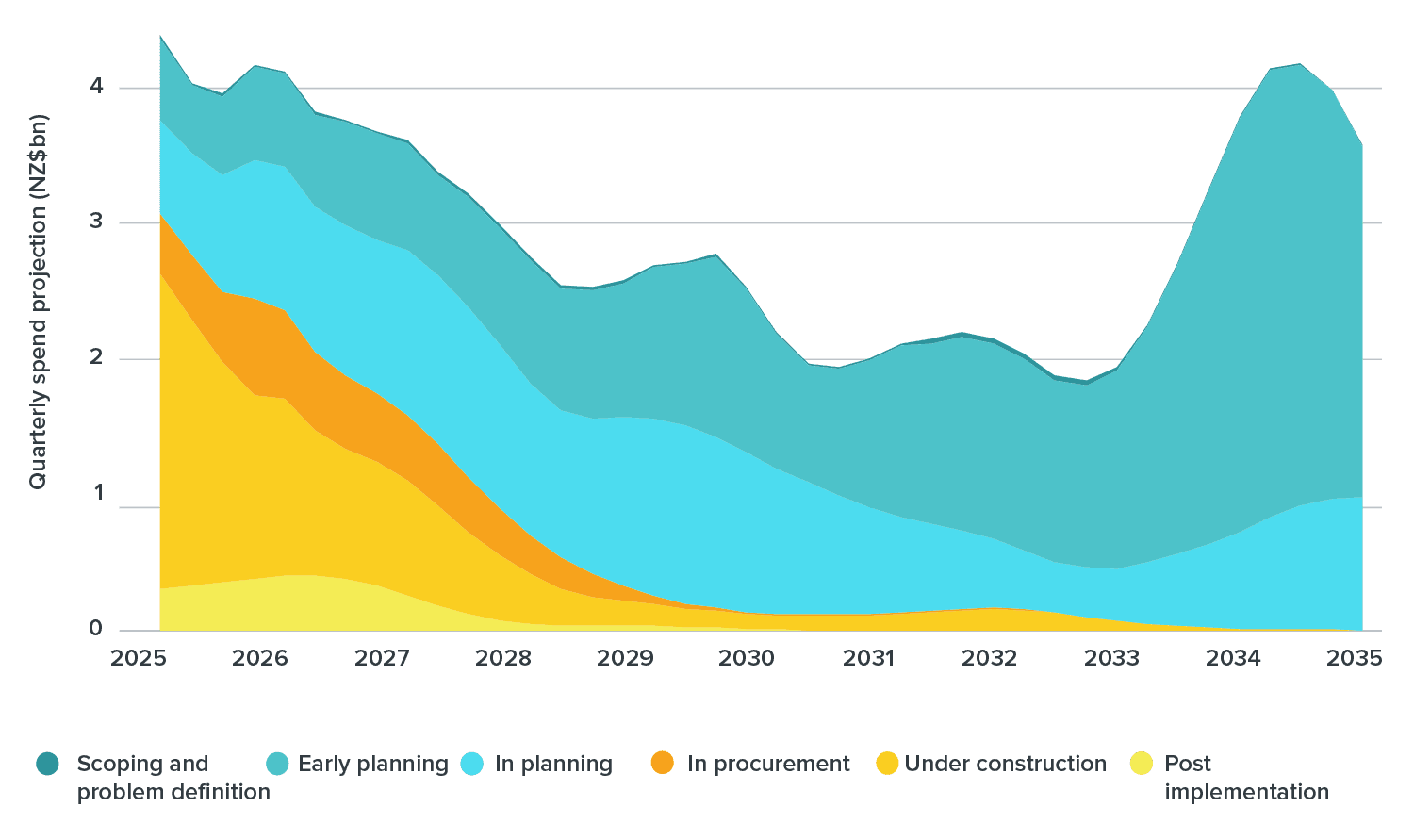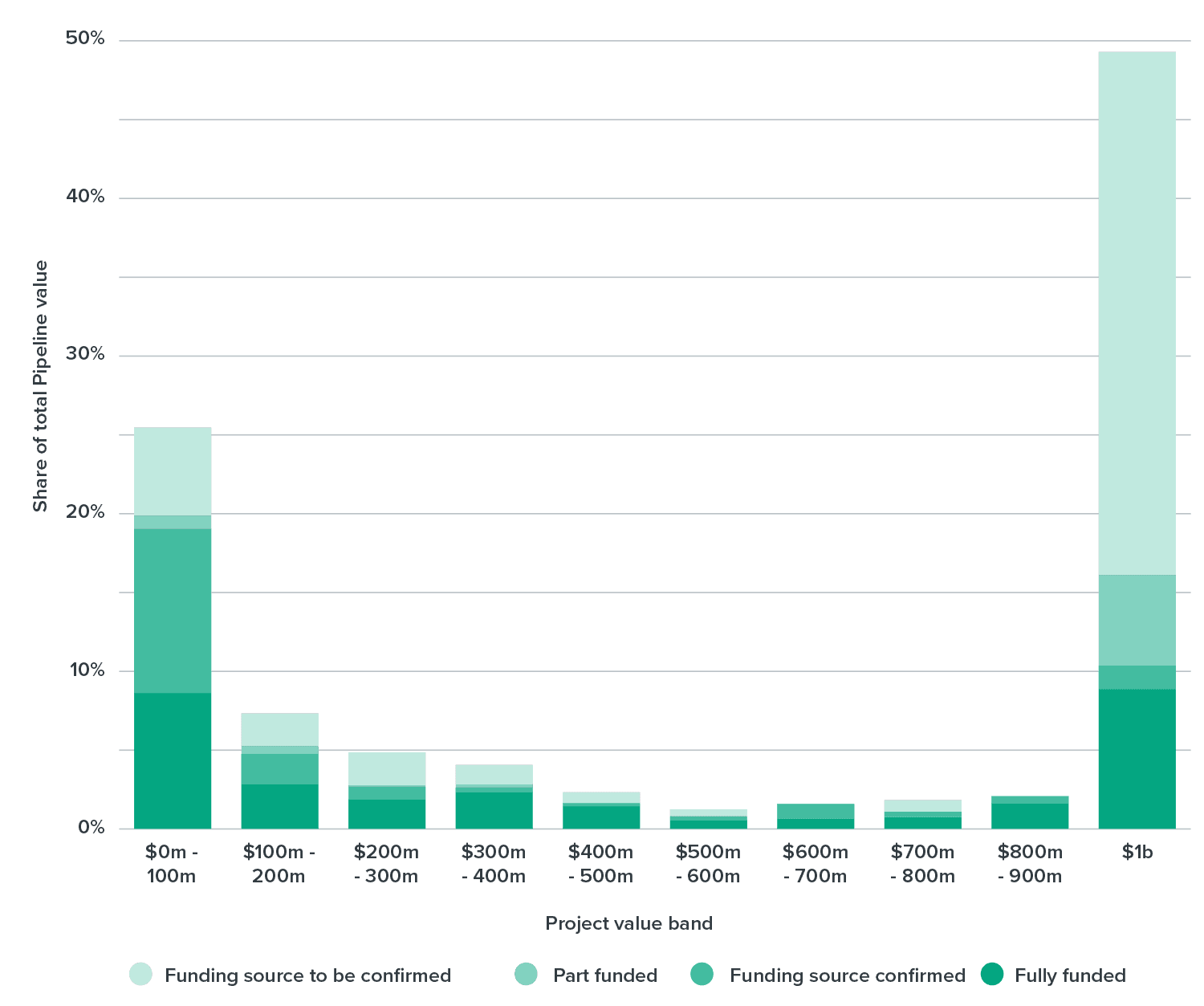Content
Content
Draft National Infrastructure Plan
6.2. Lay out upcoming project choices | He whakatakoto i ngā kōwhiringa kaupapa e whanga ana
6.2.1. Context
Projects are being planned and delivered by many different organisations. Decision-makers within a single infrastructure provider have a good understanding of their own projects but are unlikely to have a good view of other infrastructure providers’ projects.
The National Infrastructure Pipeline provides a transparent national view of current and planned infrastructure projects to help coordinate investment. The Pipeline brings together information submitted by infrastructure providers. It captures information on infrastructure projects like the location, sector, expected timing, procurement approach and expected cost of projects. However, the accuracy and currency of the data depends upon what is submitted.
The Pipeline includes over 8,100 active projects. As of the most recent update (March 2025), this accounts for around two-thirds of total infrastructure investment in the current year. We gather data from all large central government infrastructure providers, 64 councils that account for over 94% of total rates revenue, and a smaller but growing share of commercial providers.
Pipeline information is updated as agencies progress projects. We receive updated information from infrastructure providers and update the Pipeline every three months. This draft Plan includes information from the March 2025 Pipeline update. We expect the final National Infrastructure Plan to incorporate updates from the June and September 2025 Pipeline updates. After publishing the final Plan, we will continue updating project information in the Pipeline.
See list of infrastructure projects in the Pipeline
6.2.2. Strategic direction
The National Infrastructure Pipeline is used to coordinate and sequence public investment
A need exists to coordinate investment across sectors and between different infrastructure providers. This is particularly important when large projects or investment programmes are planned in places with limited resources. In the short term, the capability of the construction industry and local infrastructure workforce may not be large enough to deliver everything that’s being planned. Infrastructure providers need visibility over other things being planned, as well as an understanding of when there will be less competing activity so they can choose how to respond and make the most of opportunities.
Workforce capacity constraints are particularly important after large natural hazard events. A lot of infrastructure needs to be rebuilt after an earthquake or extreme weather event. Workforce capacity constraints typically mean that the rebuild must be sequenced over multiple years, rather than delivered all at once. Sharing information through the Pipeline helps infrastructure providers to understand collective recovery needs and sequencing options, because no single infrastructure provider holds all the information that is needed, and it is disruptive to set up new information collection processes. The Pipeline provides a common platform to support bespoke information requests, integrate project data, and coordinate across providers.
Information in the Pipeline can enable infrastructure providers to coordinate with each other. Because the Pipeline includes a large and growing share of planned infrastructure investment, it provides the most comprehensive view of anticipated demand, current constraints and sequencing opportunities. To support this, Pipeline data can be presented at a regional or sectoral level, as well as highlight investment themes, such as initiatives to recover from a natural hazard event. Workforce requirements to deliver projects in the Pipeline are also modelled and presented.
Projects’ planning and funding status are transparent to decision-makers and the public
Project choices should be clear. A difference exists between projects that are in procurement or delivery, and those that are unfunded and in various stages of planning. Projects in procurement or delivery represent existing funding commitments made by decision-makers. Unless significant changes occur, for instance large unforeseen cost or scope changes, these commitments should stand. By contrast, unfunded projects in the planning stages represent choices that are still available.
Infrastructure providers and the construction sector should treat unfunded projects as more uncertain than funded ones. While it is important to have visibility over projects in planning that may proceed, they will not all be funded. Priorities and project costs may change, or it may not be affordable to build everything that’s being explored.
The Pipeline presents what we currently know about available project choices. We use the information received from infrastructure providers about their initiatives to model the projected spend to deliver projects in the Pipeline (Figure 35). In the near term, most of these projects are under construction or in procurement. In later years, most projects that are in various stages of planning, from scoping and problem definition through to detailed planning before a funding decision. This reflects the fact that infrastructure providers do not make detailed financial commitments many years in advance.
Projects in the planning stages need to be robustly tested. The quality of upfront planning shapes whether projects can be successfully delivered with the desired benefits. The Pipeline explains the activity within the infrastructure system through the collection of a common set of information across all known infrastructure initiatives in planning and delivery. However, it does not test the quality of these projects or investments. Other tools, like the Infrastructure Priorities Programme discussed below, are needed to test project quality.
Most unfunded projects in the Pipeline are in the early planning stages

Source: ‘March 2025 Pipeline snapshot’. New Zealand Infrastructure Commission. (2025).
Figure 35: Quarterly spending projections for projects in the Pipeline, 2025–2035
Opportunity costs of investment choices are clearly identified
Choosing to fund one project may limit our ability to pay for something else. This situation is particularly important for central government infrastructure, where systematic misalignment can occur between investment intentions and available funding (see Section 4). The Pipeline helps to provide transparency of these initiatives. The opportunity costs of investment need to be recognised by decision-makers.
Decision-makers should anticipate the need for both large and small projects. Some large projects are planned far in advance, reflecting their complexity, size and scale relative to market capacity but smaller projects do not need to be planned as far in advance before they are expected to be needed. As a result, longer-term Pipeline spending projections mainly reflect large projects in the planning stages. But, if too many large projects are committed years in advance, it will limit our ability to fund smaller projects that will be needed later.
The Pipeline presents information on projects of all sizes. While major projects that can cost a billion dollars or more can often draw focus, most individual projects are much smaller. The Pipeline includes 7,918 projects with an expected cost of less than $100 million, 97% of all initiatives by number. These projects account for 25% of the total value of projects in the Pipeline. At the other end of the scale, the Pipeline currently includes 28 ‘megaprojects’ with expected costs of $1 billion or more, accounting for 49% of the total value of projects in the Pipeline.
Transport megaprojects pose the biggest upcoming choices. Almost half of the total value of projects in the Pipeline – $95 billion out of $207 billion – do not yet have committed funding (Figure 36). Most of the unfunded value comes from a small number of large projects, mostly in land transport, and large projects are much less likely to have confirmed funding. Whereas 78% of the aggregate value from small projects has confirmed funding or a funding source, only 33% of the value of large projects has a confirmed funding source. Choices about funding these projects will therefore have a large impact on what else we can afford to do.
Table 5 provides a list of large projects in the planning stages that infrastructure provides have submitted to the Pipeline as of March 2025.
Table 5: Large projects in the planning stages
Download
Larger initiatives account for a significant proportion of projected spending but are largely unfunded

Source: ‘March 2025 Pipeline snapshot’. New Zealand Infrastructure Commission. (2025)
Figure 36: Distribution of initiatives in the Pipeline by expected project cost, as of March 2025
Barriers to making informed decisions are minimised
The National Infrastructure Pipeline is an important evidence base for understanding the state of the infrastructure system. The Pipeline is New Zealand’s national dataset of infrastructure initiatives providing transparency on investments and activity to maintain, renew, and improve the infrastructure we all rely on. This evidence base supports the Commission’s advice, along with funding and policy decisions that affect construction demand and supply of resources including workforce.
Important information should be available on infrastructure projects and investment programmes. The Pipeline is a coordination mechanism for information on infrastructure initiatives underway and in planning from across the infrastructure system. This coordination is only effective if similar information is available for initiatives from different infrastructure providers. Infrastructure providers are invited to indicate their interest in receiving financing support from National Infrastructure Funding and Financing Limited.
Common information standards should be adopted within the infrastructure system. This is important for reducing the costs to store, share and integrate information, as well as reducing the risk of inconsistent information being provided through different channels. Not everything needs to be standardised, but basic information should be available for all programmes and initiatives, and it should be possible to track these initiatives through their lifecycle.
The Pipeline supports efficient data collection and reduces duplication across government. Ongoing quarterly updates to the Pipeline can be used to gather new information for a specific purpose and integrate with information from across government. For example, the Pipeline was used to help collect and present information on the timing of recovery and rebuild initiatives after the 2023 North Island Weather Events, as well as modelling the workforce implications of the rebuild. Other enhancements support monitoring of fast-track consenting initiatives. They will inform National Infrastructure Funding and Financing Limited’s project list for potential external investment, as well as help regulators develop a better understanding of whether infrastructure providers’ investment plans are deliverable.
The National Infrastructure Pipeline (Pipeline) is New Zealand’s national dataset of infrastructure initiatives.
The Pipeline continues to evolve and capture a greater proportion of activity within the broader infrastructure system and in March 2025 it features over 8,100 active projects from over 110 providers, representing $207 billion in value.
Of the active projects, 141 have a total expected cost of over $100m, but are recorded as not having full funding committed.[98] This list includes 13 unfunded initiatives over $100 million that have been endorsed through the first round of the Infrastructure Priorities Programme and notes the stage they have been endorsed at.
The Pipeline is updated by organisations every three months as these infrastructure initiatives progress through their lifecycle. The information recorded included details like the status, location, sector, expected timing, procurement approach, and expected cost.[99] Table 5 reflects information from the March 2025 Pipeline update. The final National Infrastructure Plan will incorporate updates from the June and September 2025 Pipeline updates. The Commission will continue routinely updating information in the Pipeline making insights available to infrastructure providers and the market after the final Plan is published.